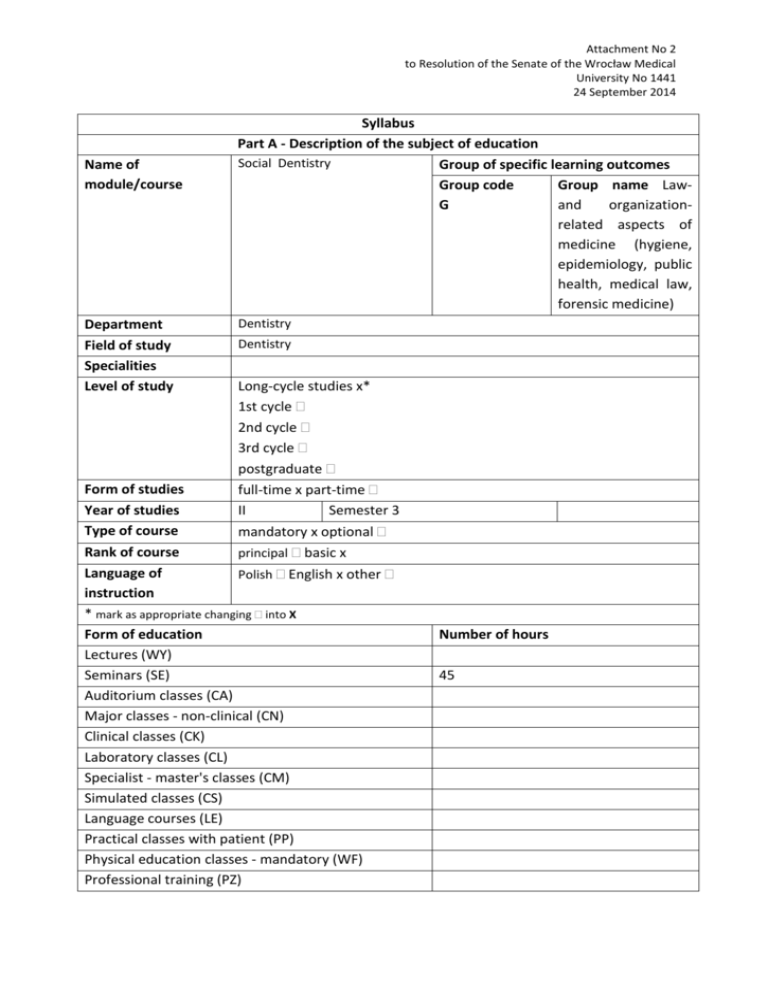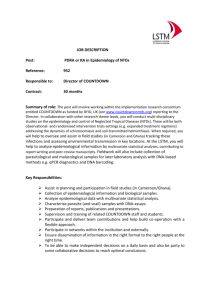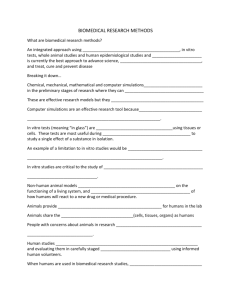Sylabus - Umed.wroc.pl
advertisement

Attachment No 2 to Resolution of the Senate of the Wrocław Medical University No 1441 24 September 2014 Name of module/course Department Field of study Specialities Level of study Syllabus Part A - Description of the subject of education Social Dentistry Group of specific learning outcomes Group code Group name LawG and organizationrelated aspects of medicine (hygiene, epidemiology, public health, medical law, forensic medicine) Dentistry Dentistry Long-cycle studies x* 1st cycle 2nd cycle 3rd cycle postgraduate full-time x part-time II Semester 3 Form of studies Year of studies Type of course mandatory x optional Rank of course principal basic x Language of Polish English x other instruction * mark as appropriate changing into X Form of education Lectures (WY) Seminars (SE) Auditorium classes (CA) Major classes - non-clinical (CN) Clinical classes (CK) Laboratory classes (CL) Specialist - master's classes (CM) Simulated classes (CS) Language courses (LE) Practical classes with patient (PP) Physical education classes - mandatory (WF) Professional training (PZ) Number of hours 45 Self-education Other 90 In total 135 Educational goals: 1. Familiarity with basics of hygienic way of life, studying and work, hand hygiene. 2. Familiarity with basics of epidemiology, population health status indicators, kinds of epidemiological studies, deriving conclusions from epidemiological observations. 3. Familiarity with importance of health promotion and illness prophylaxis in public health, importance of vaccination. Familiarity and understanding phenomena belonging to environmental health and environmental epidemiology (dose-effect, dose-response relationship; risk assessment). 4. Familiarity with infectious and civilization-related diseases (including caries, circulatory system diseases, cancer) - in the whole world and in Poland. 5. Familiarity with demographic indicators, their connection to health phenomena in populations and enforcing prophylactic measures. 6. Familiarity with health-driven diet and importance of diet in diseases prophylaxis and development (caries, circulatory system diseases, gastro-intestinal tract diseases, cancer). Matrix of learning outcomes for module/course in relation to methods of verification of intended learning outcomes and form of classes: The number of core education outcome W 01 The number of major education outcome GW1. Knows methods of health status evaluation in patients and populations GW2. Knows methods of identification and evaluation of risk factors, positive and negative aspects of different types of epidemiologi cal studies and measuremen Student who passes the module/course has the knowledge of/knows how to/is capable of Please formulate approx. 5 to 7 learning outcomes (examples of verbs to describe learning outcomes regarding knowledge: describes, defines, explains) Describe demographic structure of populations and evaluate their health problems, determining health risks. Set up epidemiological study plan, set its aim and collect information concerning risk factors of infectious and chronic diseases. Plan prophylactic measures on different levels. Determine aims of primary and secondary prophylaxis. Methods of verification of intended learning outcomes achievement (forming and summary) Form of classes independently prepared presentations, written topics’ evaluations and speeches; short and long tests; oral and written responses; independent study; exam SE ** enter the symbol ts indicating causal relationships GW3 Knows epidemiology of infectious and chronic diseases, preventive methods in different stages of natural disease development and role of the epidemiologi c supervision GW5. Knows rules of health promotion, its aims and main fields of activities, including familiarity with healthy lifestyle elements’ role GW13. Interprets indicators of disease and disability presence, evaluates epidemiologi c situation of common diseases Set up simple programs and instructions concerning health promotion and properly adjust them to diagnosed needs, according to epidemiological studies. Use statistical data, interpret Evidence Based Medicine and properly choose literature and medical papers. Follow rules of working with biological and hazardous materials, know the hospital and occupational hygiene rules, follow rules of samples collecting and disposing of hospital waste, prevent samples contamination. U 01 GU1. Describes demographic structure of populations and on this basis evaluates their health problems Please formulate approx. 5 to 7 learning outcomes (examples of verbs to describe learning outcomes regarding skills: applies, performs, solves ) On the basis of data sources calculate population health indicators. Perform field collection of data concerning environmental exposure to GU2. Collects health disturbing factors information (noise, toxic substances, concerning heavy metals, vibration). presence of infectious Follow rule of health safety and chronic and hygiene. diseases’ risk factors and plans prophylactic activities on different levels K 01 Please formulate approx. 2 to 3 attitudes (examples of verbs to describe learning outcomes regarding attitudes: creates, eagerly participates in, cooperates with the group, actively participates in) Create pro-health behaviors, actively participates in didactic process and different forms of activities: discussion, presentation preparation, group work. **WY - lecture; SE - seminar (SE); auditorium classes - CA; CN - principal classes (non-clinical); CL - laboratory classes; CN specialist (master's) classes; CS - simulated classes; LE - language courses; PP - practical classes with patient; WF - physical education classes (mandatory); PZ - professional training; SK - self-education Put a cross on a 1 to 3 scale to mark how the above outcomes categorize your classes in terms of knowledge, skills and attitudes e.g.: Knowledge + + + Skills + + Attitudes + Student's workload (the ECTS credit balance): 4 Form of student's workload Student's workload (h) (attendance, initiative, preparation to classes, verification etc.) 1. Contact hours 45 2. Time dedicated to student's own work 90 Total student's workload 135 The ECTS credits per module/subject 4 Remarks Classes content: (please put down the classes subject matter in a concise form with the consideration of the form of classes and bearing in mind the fact that the subject matter should translate into the intended learning outcomes) Lectures 1. 2. 3. Seminars 1. Hygiene and health promotion - basic terms. Basic rules of food hygiene and diet. Calculating of energetic demand. Basic metabolism, activity-related metabolism. Nutrients’ role. Disturbances in human nourishment. 2. Nurishment’s role in diseases development and prophylaxis (circulatory system diseases, cancer, caries, gastro-intestinal tract diseases). Independent acquiring and presentation of knowledge concerning diet, hygiene and prophylaxis - exercises in using medical literature. 3. Influence of chosen environmental factors on human health. Air pollution, dust influence on circulatory and respiratory system, mountain hypoxia - negative and positive influence of highmountain environment on human health. 4. Influence of chose environmental factors on human health. Heavy metals - ways of absorption, acting on organism, intoxications and their therapy. Physical factors exposure at work and beyond - health consequences. 5. Definitions, aims, tasks of epidemiology. Epidemiological sciences. Health indicators. Demographic phenomena. 6. Types of epidemiological studies (descriptive, analytical, ecological, clinic-control, cohort, case studies). Experimental studies. Common mistakes in epidemiological studies. 7. Environmental epidemiology. Environment and health. Exposure and dose. Dose-effect and doseresponse relationship, risk assessment. Specific factors in environmental epidemiology and occupational medicine. 8. Circulatory system diseases + colloquium 9. Hands hygiene. Washing and disinfection of hands. “Dirty hands diseases” - exercises using lamps. Hospital infections - epidemiology. Workplace hygiene guidelines for medical occupations. 10. Chosen examples of successes in diseases prophylaxis. National program for nervous cell prophylaxis. Guidelines for using vitamin D, vaccination programs, caries epidemiology. Prevention of caries and other mouth diseases. 11. Substance dependency problems (nicotine, ethanol, drugs). 12. Environmental health hazards at home and work. 13. Rules of health promotion and diseases prophylaxis. Macroeconomic aspects. 14. Screening for diseases. Epidemiology of infectious diseases and cancer. National program for fighting neoplastic diseases + colloquium Making up failed colloquia and missing classes. Classes 1. 2. 3. Other: 1. 2. 3. etc. Core literature: (according to relevance, no more than three titles) 1. Bonita R, Beaglehole R, Kjellström T. Basic Epidemiology. 2 ed. Geneva: World Health Organization; 2006. [Available from: http://whqlibdoc.who.int/publications/2006/9241547073_eng.pdf] 2. Dietz E, Badavinac R. Safety Standards and Infection Control for Dental HygienistAlbany, NY: Delmar; 2002. 3. Chattopadhyay A. Oral Health Epidemiology. Principles and Practice. Sudbury, MA: Jones & Bartlett Publishers; 2011. Supplementary literature and other aids (no more than three titles) 1. Atlas of Health in Europe. 2 nd ed. Copenhagen: WHO Regional Office for Europe; 2008. 2. Hill MK. Understanding Environmental Pollution. 3rd ed. Cambridge: Cambridge University Press; 2010. 3. Truswell AS. ABC of Nutrition. 4th ed. London: BMJ Publishing Group; 2003. Requirements regarding teaching aids: (e.g. laboratory, multimedia slide projector, other) Exercise room equipped with multimedia projector and portable computer Initial conditions: (minimal conditions to be fulfilled be a student before signing up for the module/course) Basic knowledge in the fields of: human anatomy, basic medical chemistry, public health Terms of passing a given course: (please define the form and terms of passing given classes falling within the scope of the module/course, rules for allowing students to sit final theoretical and/or practical exam, its form and requirements that students must meet in order to pass it as well as criteria applicable to each grade) 1. Presence in 90% of seminars, active participation and group-work; alternatively: studying independently missing topics and making up the missing classes (no more than 2). 2. Positively passing all unannounced short tests during seminars. 3. Positively passing all written colloquia - open questions; open answers questions demanding: naming, defining, explaining, filling in; problem tasks; calculation tasks; interpreting calculation results and external data. 4. Preparing and presenting at least 1 presentation concerning assigned topic. Exam: written form - test. Grade: very good (5,0) good plus (4,5) excellent (4,0) fairly good (3,5) satisfactory (3,0) Criterion for assessment: (applies only to courses/modules ending with an exam) At least 93% correct test questions answers. Very good mastering of topics covered in seminars and by basic and additional sources. Unrestrained covering problems of social dentistry, hygiene and epidemiology. Good understanding and diligent explaining of interactions and connections between determined (risk) factors and health phenomena. Interpretation of external data and fluent solving problems and fulfilling complicated tasks. At least 85% correct test questions answers. Very good mastering of topics covered in seminars and by basic and additional sources. Good understanding problems of social dentistry, hygiene and epidemiology. Proper interpretation of external data and fluent solving problems and fulfilling tasks. At least 75% correct test questions answers. Good mastering of topics covered in seminars and by basic and additional sources. Proper interpretation of external data and solving of most problems and fulfilling most tasks. At least 70% correct test questions answers. Good mastering of topics covered in seminars and by basic sources. Interpretation of external data and solving basic, simple problems and fulfilling basic, simple tasks. At least 60% correct test questions answers. Sufficient mastering of topics covered in seminars and by basic sources. Solving basic, simple problems and fulfilling basic, simple tasks Name and address of the unit in charge of module/course, contact (phone number and email address) …… Department of Hygiene… ul. J. Mikulicza-Radeckiego 7, 50-435 Wrocław, tel.: 71 784 01 05, 71 784 15 01, 71 784 15 02, faks: 71 784 15 03 e-mail: wl-10@umed.wroc.pl A list of persons giving particular classes including: full name, degree/academic or professional title, field of science, profession, form of classes Robert Susło, MD, PhD Prepared by: Revised by: Robert Susło, MD, PhD Iwona Markiewicz-Górka, PhD ………………………………………….. Prof Krystyna Pawlas Signature of the Head of unit in charge of classes …………………………………………..






